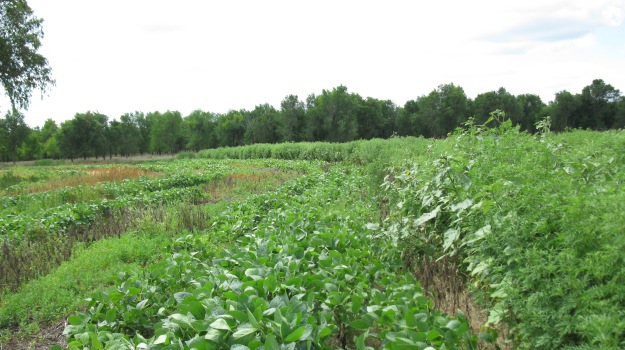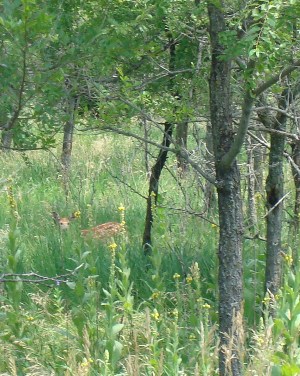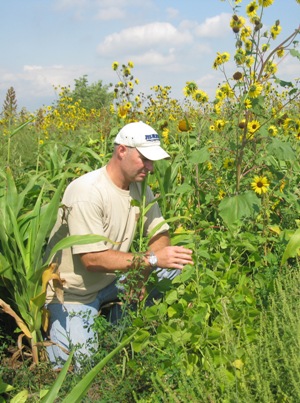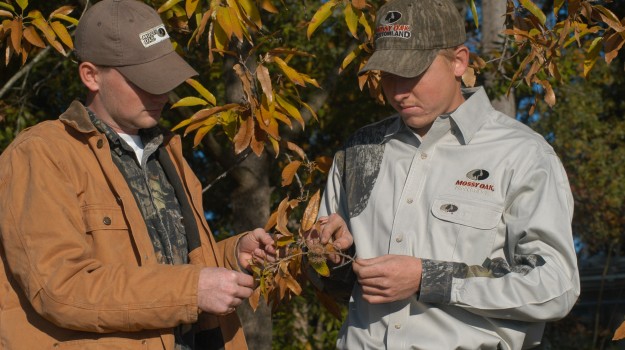
Simple Techniques for Creating Transitional Succession Habitats
By Dana R. Rogers
Very few things worth having in life come free, still fewer of them seem to happen quickly. As a land manager, when trying to increase cover we have many options available to us and most of them seem to take years to come to fruition. Most of them seem to come with an increasingly steep price tag. Grain seed for food plots like corn and soybeans is rising sharply, especially if you choose Roundup Ready varieties. Fuel, fertilizer and chemical herbicides all push for a larger piece of our management budget each year. Planting trees and shrubs is obviously one of the preferred methods of increasing cover and wildlife habitat but seeing any measureable growth is calculated more in decades than hunting or growing seasons.
Like most of you I put plenty of time, effort and money into all of the previously mentioned food plot and habitat improvement projects. But I’ve also discovered a different, more economical way to quickly and efficiently increase the ground cover on our family ranch. Like most areas that have seen traditional cattle grazing operations, our family ranch has been dominated by brome grass for decades. Gone are the seas of tall and short grass prairies of big bluestem, Indian grass and side oats grama that once stretched from the Canadian Prairie Provinces down to central Texas.
When I began to work a few acres of prairie grass into food plots 5 years ago I stumbled upon an added benefit. Much of the land I was allowed to plant into food plots hadn’t been farmed for over 50 years and it had long reverted back to near virgin prairie. During that first year I planted a few acres into sorghum without the use of any herbicide. Later that summer what I found was a burgeoning floral, grass and broadleaf edge that sprang nearly 5 feet in many places. By opening up the seed bank to sunlight and releasing the land from the grips of the brome grass, I’d created a mini shelter belt of cover and seeds for all manner of bird and mammals to use.
 Strip disking in its simplest definition involves the purposeful disturbance of the soil to release sod-bound fields. It creates bare ground by reducing matted litter accumulation, stimulates germination of desirable seed-producing plants, and increases insect populations for birds to feed upon. Strip disking is one of the simplest, most effective, and cost effective techniques for improving wildlife habitat. Deer, pheasant, turkey, rabbits, and songbirds are some of the many species that benefit. Strip disking simply involves the use of a disk to disturb the soil. Disking provides numerous benefits to improve wildlife habitat. I set back natural succession by cutting up and killing the grassy brome.
Strip disking in its simplest definition involves the purposeful disturbance of the soil to release sod-bound fields. It creates bare ground by reducing matted litter accumulation, stimulates germination of desirable seed-producing plants, and increases insect populations for birds to feed upon. Strip disking is one of the simplest, most effective, and cost effective techniques for improving wildlife habitat. Deer, pheasant, turkey, rabbits, and songbirds are some of the many species that benefit. Strip disking simply involves the use of a disk to disturb the soil. Disking provides numerous benefits to improve wildlife habitat. I set back natural succession by cutting up and killing the grassy brome.
Before I ran our aggressive off-set disk over our pasture we had nothing but a thick mat of grass. Areas like this are typically filled with fescue, brome, or canary grass. Those species have little to no value for our local wildlife species. Strip disking encourages the natural re-generation of annual warm season grasses and forbs that are a major native wildlife food source. These species provided our ranch with vital pheasant and turkey brood rearing habitat that provides newly hatched chicks a diet rich in insects. I’ve also witnessed does with new fawns in tow bed them down in these thick stands as they browsed on broadleaf plants also created by this process.
When the soil is exposed by strip disking, seeds of annual plants can germinate and grow from the seed bank, which greatly enhances plant diversity. Most of the acres that were strip disked were a monoculture of cool season grass. Many of the new annual plants produce seeds or leafy browse that provides food and cover during late summer. But my favorite byproduct of strip disking is the screening cover and thermal boundary it provides during our brutal South Dakota winters. Screening cover also provides our deer a sense of security and helps hide them while they feed from the prying eyes of possible road hunters or poachers.
If turkeys and pheasant habitat production is a goal, strip disking creates areas of bare soil that provide dusting areas for birds or new areas for sowing additional types of seeds valuable as wildlife food and cover. Through several years of trial and error, I’ve achieved the best results by practicing strip disking along the edges of our shelter belts or lower profile food plots like clover or soybeans. Our pasture grasslands, where there is little or no edge, are transformed to productive wildlife habitats through this simple process. Many habitat managers might call this practice a form of “edge feathering”.
According to a local upland game biologist who I consult with on habitat questions, strip disking should be done in linear strips at least two disk-width’s or between 15’- 20’ across. Additionally, to prevent erosion, the strips should follow the contour of the land and be separated by un-disked strips at least as wide as the disked area. All that needs to be accomplished is to work the ground deep enough to kill the majority of the existing vegetation. If the sod-matte is too thick to allow adequate soil disturbance with a disk, then haying, plowing, herbicides a controlled burn or any combination can be used to remove the vegetation prior to disking. I’ve tried most of the alternative methods but I usually wind up just working the strips several times with a good aggressive ganged off-set disk until the soil is turned thoroughly. Another alternative to strip disking that I have enjoyed fantastic success with is the use of selective or non-selective herbicides.
Strip disking is my preferred method for quickly adding forbs and security cover next to my food plots and timbered areas. But one problem that plagues us on our farm is that within the timber there is virtually no re-growth of new trees due to the thick pasture of brome and fescue that covers the closed canopy. I could burn or pursue TSI cuttings but with the limited amount of trees we have I chose to use herbicide to kill the grass and spur on new growth.
By using a backpack sprayer and/or ATV spray rig I have walked or driven through gaps in the trees and used a 3% mixture of glyphosate to knock back the grass. This has provided an enormous increase in ground cover in our woods and as with strip disking it also adds greatly to the forbs and other preferred browse species our whitetails rely upon. Early May seems to be the best time to apply the herbicide, when the cool season grasses are really starting to green up and grow in our area. Using herbicides will take longer than actual tillage and I typically don’t see the great flush of growth until the 2nd year. After that second year I often come back and hit the area with a broadleaf specific chemical like 2-4D if I’m looking to select for warm season grasses in that area.
If you don’t want to use a non-selective herbicide like glyphosate (Round-Up) you can get a good kill on your brome or fescue with grass specific herbicides like Poast, Select or Arrow. These are certainly not the only herbicides to use to rid your stand of cool season grasses like Johnson, brome or fescue. I experiment from strip plot to strip plot. In some areas I select for broadleaf forbs in others I try to push the remnants of the native warm season grasses. This can be accomplished through the use of different chemicals as well.
According to Thomas G. Barnes of the Natural Areas Journal, herbicides show great promise as a useful tool for removing tall fescue from remnant grasslands and enhancing NWSG and selected broadleaf plants in native grassland systems. His study evaluated the efficacy of imazapic, clethodim, and sulfosulfuron for removing tall fescue and releasing the native warm-season grasses and to document which species of broadleaf plants survive a post-emergence treatment of 0.2 kg ai/ha of imazapic or 0.03 kg ai/ha sulfosulfuron. All three herbicides reduced the amount of total vegetative cover after the first growing season, but there were no differences by the end of the second growing season. After the first growing season, imazapic- and sulfosulfuron-treated plots had less tall fescue than clethodim-treated plots, but there was no difference by the end of the second growing season. NWSG increased the most in the imazapic-treated plots and second most in the sulfosulfuron-treated plots. NWSG did not increase in the clethodim-treated plots when compared to the controls after the first growing season.
The overarching goal I pursue with strip disking and through the use of herbicides on our grasses is achieving a diverse range of plant species, preferably those that provide food as well as tall, thick thermal cover. I further diversify the edge by using a rotational approach. By setting up a 3-5 year rotation with adjacent strips I achieve outstanding habitat throughout an early succession range. Keep in mind, with the use of herbicides I am typically a year behind conventional tilling methods. However, herbicides have the added benefit of helping to reduce erosion and top soil loss by keeping a thatch of dead plant materials as mulch.
 A typical rotation might look like this - the first year after disking, heavy seed-producing plants, such as foxtail, ragweed, and lespedeza will quickly volunteer into the disturbed soil areas and provide high-energy, winter food supplies and attract insects for birds to feed upon. The disked areas will be open enough at ground level for easy movement by pheasant, turkey, quail broods as well as small mammals.
A typical rotation might look like this - the first year after disking, heavy seed-producing plants, such as foxtail, ragweed, and lespedeza will quickly volunteer into the disturbed soil areas and provide high-energy, winter food supplies and attract insects for birds to feed upon. The disked areas will be open enough at ground level for easy movement by pheasant, turkey, quail broods as well as small mammals.
During the second and third year after disking, perennial forbs, legumes and grasses will begin to become established. The amount of bare ground, interspersed among the erect vegetation, begins to decline. Annual plants are still abundant and continue to provide rich sources of insects and winter foods. This stage of succession provides important loafing and roosting habitat for birds and bedding cover for our whitetails.
During the fourth and fifth year after disking seed-production seems to decline. Grasses and forbs dominate the area and debris accumulates. Tree seedlings begin to show good growth in the strips. At this stage of the succession process habitat conditions may have gotten as good as they will ever get and the process reverts to a decline. To keep the adjoining segments diverse this is when I disk the strip again in the spring or hit it again with a non-selective herbicide to begin the process anew.
For those landowners and managers with property in a government easement such as the CRP or WRP, some states allow strip disking or the use of herbicides to improve those lands that have lost their vegetative diversity and value to wildlife. Strip disking should only be conducted outside the nesting period of upland birds in your area.
You also need to take the elevation and grade into consideration to keep your top soil from eroding. One of the main sticking points in my area of the plains is wetlands. Be sure to steer clear of any wetland sloughs and make sure you leave a grassy buffer strip between the wetlands and your strip disking efforts to keep water quality at a high level. Another important aspect with strip disking is the introduction and suppression of noxious weeds. We have a terrible Canadian thistle problem in our area; I am constantly going back and spot spraying to keep them at bay once I’ve disturbed the soil on our ranch.
There are many ways to increase ground cover for bedding and thermal cover in the northern regions. Using methods like strip disking and through the use of selective and non-selective herbicides, I've given our habitat a kick start by using long dormant native grass seedlings to overtake areas long held by invasive brome grass in the Upper-Midwest. It takes several years to plant and grow trees to create habitat that wildlife can use. But with these techniques I've created thick stands of bedding cover with lush forbs and bugging areas used by upland birds. I rotate grass specific herbicides or non-selective herbicides with later minimal or conventional till plantings to create transitional succession habitats that our upland game birds and whitetails have really taken to.
If you want further information or have questions on simple habitat management improvement projects like strip disking. I suggest contacting your local biologist or NRCS office.






























